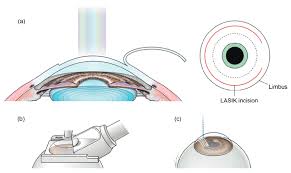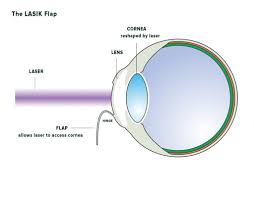Table of Contents
ToggleIn today’s world, the pursuit of perfect vision without the need for glasses or contact lenses is more achievable than ever.
Thanks to advancements in medical technology, several surgical options are available to correct refractive errors such as myopia (nearsightedness), hyperopia (farsightedness), and astigmatism.
Among the most popular procedures are LASIK, LASEK, and SMILE. Each of these procedures presents distinct advantages and considerations.
In this comprehensive guide, we will explore the differences, advantages, and potential drawbacks of LASIK, LASEK, and SMILE to help you make an informed decision about which might be the best option for you.
Understanding Refractive Errors
Before we dive into the specifics of each surgery, it’s important to understand what refractive errors are and how they affect vision.
Refractive errors manifest when the anatomical shape of the eye hinders light from focusing directly on the retina. This can result in blurred vision, which can be corrected with glasses, contact lenses, or refractive surgery.
Types of Refractive Errors
- Myopia (Nearsightedness): Difficulty seeing distant objects clearly.
- Hyperopia (Farsightedness): Difficulty seeing close objects clearly.
- Astigmatism: Vision that is distorted or blurred as a result of an irregularly shaped cornea or lens.
- Presbyopia: Age-related loss of near vision.
With this foundational knowledge, let’s move on to the specific procedures.
What is LASIK?
How LASIK Works
LASIK (Laser-Assisted In Situ Keratomileusis) is one of the most well-known and commonly performed laser eye surgeries.
The procedure involves creating a thin flap in the cornea, the transparent front part of the eye. After lifting the flap, an excimer laser reshapes the underlying corneal tissue to correct the refractive error. The flap is then repositioned, serving as a natural bandage for the healing process.
Benefits of LASIK
- Quick Recovery: The majority of patients typically observe a substantial enhancement in their vision within a 24-hour period.
- Minimal Discomfort: The procedure is relatively painless, with only mild discomfort during healing.
- High Success Rate: LASIK exhibits a high success rate, with numerous patients attaining 20/20 vision or better.
- Long-Lasting Results: The outcomes of LASIK are typically stable and enduring.
Potential Drawbacks of LASIK
- Dry Eyes: Certain patients may experience dryness of the eyes following surgery.
- Night Vision Issues: Halos and glare around lights at night can occur, though these usually diminish over time.
- Flap Complications: Although rare, complications with the corneal flap can arise.
What is LASEK?
How LASEK Works
LASEK (Laser-Assisted Sub-Epithelial Keratectomy) is similar to LASIK but differs in the way the cornea is accessed. Instead of creating a flap, the outermost layer of the cornea (the epithelium) is loosened with an alcohol solution and then moved aside. An excimer laser is employed to remodel the corneal tissue beneath the surface. Subsequently, the epithelium is carefully repositioned over the treated region.
Benefits of LASEK
- No Flap Complications: Since no corneal flap is created, there’s no risk of flap-related complications.
- Suitable for Thin Corneas: LASEK is an option for patients with thinner corneas, where creating a LASIK flap may not be possible.
- Less Risk of Dry Eyes: Compared to LASIK, LASEK may present a lower risk of dry eyes.
Potential Drawbacks of LASEK
- Longer Recovery Time: Vision may take longer to stabilize compared to LASIK.
- Discomfort: Patients may experience more discomfort during the healing process.
- Temporary Haze: Some patients report a temporary haze in their vision during recovery.
What is SMILE?
How SMILE Works
SMILE (Small Incision Lenticule Extraction) is a minimally invasive laser eye surgery that uses a femtosecond laser to create a small, lens-shaped piece of tissue (lenticule) within the cornea. The lenticule is then removed through a small incision, allowing the cornea to change shape and correct the refractive error.
Unlike LASIK and LASEK, SMILE does not involve creating a large corneal flap or moving the epithelium aside.
Benefits of SMILE
- Minimally Invasive: The small incision means less disruption to the cornea and quicker recovery.
- Reduced Risk of Dry Eyes: The smaller incision may result in a lower incidence of dry eyes.
- Stable and Predictable Results: SMILE provides consistent and stable visual outcomes.
- Quick Recovery: Many patients experience rapid visual recovery with minimal discomfort.
Potential Drawbacks of SMILE
- Limited Availability: SMILE is a newer procedure and may not be as widely available as LASIK or LASEK.
- Not for All Refractive Errors: Currently, SMILE is primarily used for correcting myopia and astigmatism and may not be suitable for other refractive errors like hyperopia.
- Skill Dependent: The success of SMILE may heavily depend on the surgeon’s experience and skill.
Comparing LASIK, LASEK, and SMILE
Now that we have a detailed understanding of each procedure, let’s compare them across several key factors:
Procedure
- LASIK: Involves creating a corneal flap.
- LASEK: Involves loosening the epithelium with an alcohol solution.
- SMILE: Involves the creation and removal of a lenticule through a minimal incision.
Recovery Time
- LASIK: Quick recovery, with significant improvement in vision within 24 hours.
- LASEK: Longer recovery time, with vision stabilizing over several days to weeks.
- SMILE: Quick recovery, with rapid visual improvement and minimal discomfort.
Suitability
- LASIK: Suitable for most patients with adequate corneal thickness.
- LASEK: Suitable for patients with thinner corneas or those at risk of flap complications.
- SMILE: Suitable for patients with myopia, particularly those with dry eye concerns.
Risk of Dry Eyes
- LASIK: Moderate risk.
- LASEK: Lower risk compared to LASIK.
- SMILE: Lowest risk among the three.
Complication Rates
- LASIK: Risk of flap-related complications.
- LASEK: Risk of epithelial complications.
- SMILE: Reduced risk of complications due to the minimally invasive nature.
Cost
- LASIK: Generally more affordable.
- LASEK: Similar cost to LASIK.
- SMILE: Slightly higher cost due to newer technology.
Making the Decision
Selecting the appropriate procedure is contingent upon various factors, including the specific refractive error, corneal thickness, lifestyle considerations, and individual preferences. Consulting with a qualified ophthalmologist or eye surgeon is crucial to determine which procedure is best suited for your individual needs.
Factors to Consider
- Eye Health: Ensure you do not have any underlying eye conditions that could affect surgery outcomes.
- Lifestyle: Consider your daily activities and how quickly you need to return to them after surgery.
- Comfort Level: Assess your comfort level with each procedure’s recovery time and potential side effects.
- Budget: Take into account the cost of each procedure and your available budget.
Moving Forward
In the realm of vision correction, LASIK, LASEK, and SMILE each offer unique pathways to achieving clear vision without the need for glasses or contact lenses.
LASIK provides quick recovery and high success rates, making it a popular choice.
LASEK offers a safer alternative for those with thinner corneas and a lower risk of dry eyes.
SMILE, with its minimally invasive approach, is quickly gaining traction for its reduced complications and quick recovery.
Ultimately, the choice between LASIK, LASEK, and SMILE should be made in consultation with a trusted eye care professional who can guide you based on your specific needs and circumstances. By understanding the differences, benefits, and potential drawbacks of each procedure, you can make an informed decision and take a significant step towards the freedom of clear vision.
If you’re considering vision correction surgery and are unsure which option is right for you, schedule a consultation with experts today.













